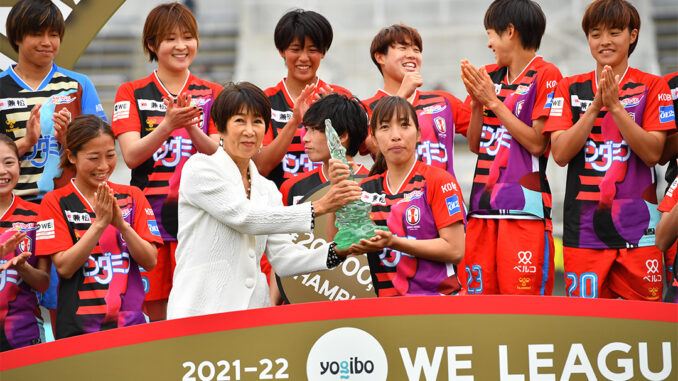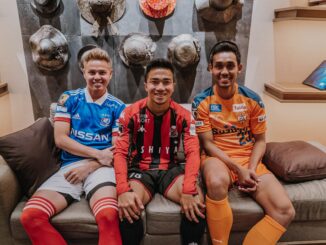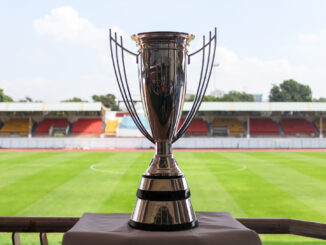
The inaugural season of Japan’s first professional women’s football league has drawn to a close after what can only be described as a season of mixed emotions. Excitement on the pitch, turbulence off it. How far have we come? How far is there to go?
INAC Kobe Leonessa were crowned inaugural WE League champions as the season reached its conclusion. The Kansai side remained dominant throughout, recording just a single loss over twenty matches.
The champions were congratulated by WE League chair, Kikuko Okajima, with remarks that encompass the overarching progressive values of the competition.
“As inaugural WE League champions, I am sure you will continue to entertain and empower fans with exciting football.”
Entertainment value was provided from the start as fans have enjoyed a league-wide improvement in technical standards in comparison with the semi-pro days of the Nadeshiko League, now Japan’s second tier.
As professionals, players are now able to commit more time to training sessions, resulting in fluid patterns of play and an easy-on-the-eye brand of football. Goals are, more often than not, well worked and achieved through enhanced levels of team synergy and tactical nous.
In the wider community, efforts have been ramped up as WE League sides participated in weekly ‘WE Action Days’. This typically involved grassroots sessions with young children and their families, increasing awareness of the league and the progressive ideals it represents.
Despite these positive developments, all has not been smooth sailing. A series of promotional and operational oversights, mainly pertaining to marketing activities and fixture scheduling, has left many fans scratching their heads.
While these shortcomings should by all means be brought to light, it would be unfair to do so without first recognising the undeniable success stories achieved so far. Keeping things in perspective, this is an inaugural season for a women’s football league turning professional in the most turbulent of times.
And on the pitch is where the majority of those success stories have unfolded.
Raising the standards to a professional level
Champions INAC Kobe are perhaps the best example of how far technical standards have risen. Patient with possession, Kei Hoshikawa’s side move the ball through the lines well as they seek to create viable scoring opportunities.
Such is the versatility of their three-back system, they are able to switch to a back five out of possession before rapidly springing forward in attack with the wingbacks joining the forwards when the ball is recovered. Prolific striker Mina Tanaka and dynamic playmaker Yui Narumiya have been key contributors to their title win.
A rung lower in second place, Urawa Reds were a prime source of entertainment. They found the net more than any other side with a total of 40 goals scored, 14 of which came from golden boot winner Yuika Sugasawa.
The youthful center back partnership of Moeka Minami and Hana Takahashi has minimized space in the defensive third, whilst adding attacking threat when playing out. Dead-ball specialist Hikaru Naomoto is able to both create and score goals with her laser-like accuracy from set-pieces and has played a key role for Reds this season.
Japan’s prime producer of Nadeshiko talent, Tokyo Verdy Beleza, currently finds itself in a state of transition. Yui Hasegawa, Mina Tanaka and Ayaka Yamashita are but a few of the homegrowns to have recently left for greener pastures, so to speak. The task now at hand is to cultivate the next crop of players into a formidable side capable of playing Beleza’s renowned brand of attacking football.
Eye-catching youngsters like Momoka Kinoshita and Aoba Fujino have already ramped up the pace of change, helping Beleza to a respectable third place finish.
JEF United Chiba Ladies and Mynavi Sendai Ladies are two sides deserving of honorable mentions. Both play with an organised and methodical approach that should be appropriately described as ‘professional’. They each have a healthy helping of national team players within their ranks and are well poised to punch a little higher than their respective fourth and fifth placed finishes next season.
On the whole, the competitiveness of the league has improved. The best players are now more evenly spread across top half teams and the landslide losses appear to be a thing of the past. We may well see a side outside the big three of INAC Kobe, Tokyo Beleza and Urawa Reds lift the trophy sooner rather than later.
Imports and Exports
Overseas interest in Japanese talent remains strong, as illustrated by two notable departures earlier in the season. Tokyo Beleza’s Jun Endo and INAC Kobe’s Hina Sugita departed midseason for the NWSL and have gone on to make an early impact at their new homes.
Endo signed with Angel City last December and has become a regular feature of the Los Angeles sides’ first team. She has started all four games so far this season, notching one goal and one assist at the time of writing.
Portland Thorns came knocking for Sugita in January of this year. The versatile midfielder made an early impact by scoring a brace in an NWSL Challenge Cup match against San Diego Wave in April, subsequently winning the NWSL’s player of the week award.
Rumor has it that several other moves are in the pipeline. The aforementioned Minami of Urawa Reds has publicly announced her decision to sign with a European side, albeit with the club name yet to be made public at the time of writing.
Conversely, Japan’s top-flight continues to house incoming talent from overseas. At the season’s end there were eight players of foreign nationality registered to WE League clubs.
“The style here is really quick and technical. Also the players have great vision and it’s helped me to up my game a lot,” exclaimed JEF United’s Quinley Quezada with clear admiration and respect for the WE League when talking with The Asian Game earlier this year.
Despite the sentiments for the league as a learning environment, there have been few foreign players who have established themselves as regular first team starters.
Seemingly, the language barriers that existed in the semi-pro era still persist. The Japanese women’s game is centered on team chemistry and tactical cohesion with communication of paramount importance. With little language support on offer, it is easy to fathom how difficult it might be for a non-Japanese speaker to assimilate into the game plan of their respective team.
The technical, fast paced nature of the Japanese women’s game proves to be a further obstacle for players coming from a league were physicality takes priority. Naturally it will take such players a little longer to adapt to the characteristics of the local game.
These barriers to entry must first be alleviated before the possibility of globally renowned names gracing the WE League can be considered.
Highlighting the operational teething pains while establishing a course for correction
However, the main areas where the WE League has struggled are to do with the packaging and presentation of the footballing product on offer.
International broadcasting issues arose early on in the season. Overseas fans were left guessing when the live YouTube streams they had been promised were not available. Technical issues were likely the cause here and, after four or five repeat occurrences, the problem was eventually resolved, but not without a fair amount of dissatisfaction caused.
Luring fans to the stadium has also been a challenge.
Chair Okajima originally set an ambitious average attendance target of 5,000 per game. Despite an encouraging start which saw INAC Kobe bring in 4,123 for their season opener against Omiya Ardija, the closing figure fell way short at a mere 1,560 average. Although plaudits are due for the National Stadium penultimate match between INAC Kobe and Urawa Reds; a spectacle that far surpassed the top-flight attendance record with a staggering 11,763.
Equally as perplexing was the scheduling of the season calendar, which ran from September to May with a whopping three-month mid-season break. Match fitness will inevitably suffer with such a gap between competitive fixtures, and this was clearly the case when INAC Kobe were dumped out of the Empress’s Cup by Tokyo Beleza’s academy side at the first game back after the hiatus.
Interlinking with the scheduling is the length of the season itself. With just 20 league games to be the WE League is one of the shortest professional leagues in women’s football. Both the WSL and NWSL play 22 games per team with an additional cup competition and the potential for international tournament qualification.
Extending the season will go some way in aiding player development, subsequently raising the level of the national side. How the league plans to award pro-status to worthy teams further down the pyramid, however, remains to be seen.
Again, persisting with patience while troubleshooting the potential root causes of these shortcomings is the more productive approach at this point.
Perhaps the most critical of setbacks came when the JFA announced a dramatic reduction of the WE League’s five-year launch budget as result of the pandemic.
At the time of conception, ¥1 billion ($786k) was pledged to assist with promotion and day-to-day running of the league in its early stages. This figure was then slashed to ¥30 million ($236k), with coronavirus countermeasures cited as the beneficiary of the amount removed. With just a third of the original budget available, the resources required to promote the league and garner support had dwindled before a ball was kicked.
The withdrawal of Japan’s bid to host the 2023 Women’s World Cup took with it the WE League’s much needed springboard tournament. Major sporting events often galvanise Japanese fans, cultivating interest in that particular sport. Without the prospect of a World Cup the league would have to generate newfound support and fandom through other means.
While the phrase ‘Women Empowerment League’ succinctly encompasses the overarching values of the league, removing the tag ‘Nadeshiko’, a name synonymous with the strength of the Japanese women’s game the world over, seems something of a branding oversight.
It stands to reason that ‘The Nadeshiko League’ is a title more likely to resonate with casual fans of the women’s game, both near and far. Arguably this should have received more consideration when the name ‘WE League’ was first coined.
By all means these early speed bumps were to be expected. The role of the league’s organisers from here is to establish a course for correction, as efforts must ensure this high potential sporting product and its progressive values is done justice. This will likely not be possible, however, without a rekindling of the JFA’s financial commitments to the levels once promised.
Former INAC Kobe domestic treble winning coach, Takayoshi Ishihara, summarized the current state of affairs perfectly when speaking exclusively with The Asian Game.
“The overall standard of the league has improved, without doubt. But much seems to be lacking on the operations side and I don’t think its entirely money related. That said, we are just starting. The best is yet to come”
Fans must also play their part and celebrate each success as it comes, no matter how big or small. Only a unified effort will see the rubber meet the road.
Photo: WE League
Listen to Episode 85 of The Asian Game podcast




